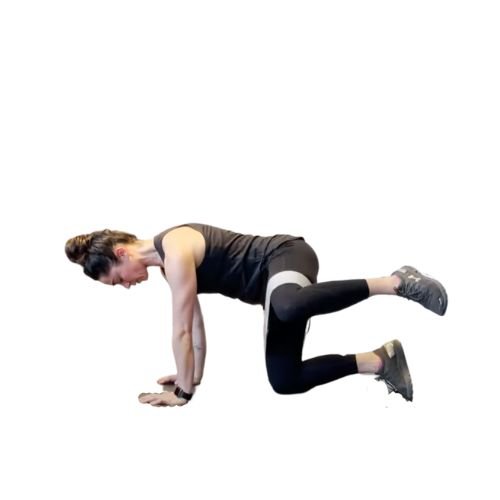Exercise Tutorial: Fire Hydrant
Table of Contents
What Is a Fire Hydrant Exercise
The Fire Hydrant Exercise is a bodyweight movement that is performed in a quadruped position. This exercise involves abducting one leg at a time so that the knee is moving out to the side. A fun fact is that the Fire Hydrant Exercise gets its name from its resemblance to a dog lifting its leg to pee on a Fire Hydrant.
How to Do Fire Hydrants
Learning how to do a Fire Hydrant Exercise is simple and will be an effective exercise to add to your repertoire! To learn how to do a Fire Hydrant Exercise, follow these easy steps:
Begin in a quadruped position. This means that your hands are on the ground underneath the shoulders, and your knees are on the ground underneath the hips. There should be a 90-degree angle in the knee.
Brace the core and begin to move one leg out towards the side by leading with the knee. Your ankle and knee will always be in alignment, and your knee should always be in line with the hip.
Once the knee has reached about hip-height, begin to lower it back down to the starting position. Repeat this movement for the required amount of reps and sets and then switch legs.
You have now learned how to perform the Fire Hydrant Exercise!
Fire Hydrant Form
Even though the Fire Hydrant Exercise is simple to learn and perform, small errors in form can have a big impact on the effectiveness of the exercise. To maintain proper
Fire Hydrant Form, follow these tips:
Keep a 90-degree angle in the knees
The hips should always be parallel to the floor (no twisting or tilting)
Maintain a neutral spine and brace the core
Perform a slow and controlled movement
The ankle should always be in line with the knee
Keep the arms straight, and balance your weight evenly
Following these Fire Hydrant Form tips will help you to reap all of the benefits of this exercise. For instance, allowing your hips to move will not activate the Glutes to their full potential.
Fire Hydrant Benefits
The Fire Hydrant Exercise has many benefits, which is why it is so popular. Along with strengthening the core, the Fire Hydrant Exercise is beneficial for increasing hip extension, external rotation of the hip and abduction of the hip. This is all from the activation of the Glutes, which will become more prominent and toned from the consistent practice of the Fire Hydrant Exercise!
Why Is The Fire Hydrant Exercise Useful
The Fire Hydrant Exercise is useful mainly because it strengthens the Glutes. Strong Glutes help to reduce low back pain, improve posture and reduces the risk of injury during many of our everyday movements. Additionally, many women enjoy performing this exercise because of the enhanced appearance it can give the Glutes.
Fire Hydrant Exercise Results
Some direct Fire Hydrant Exercise Results include:
Increased tone and strength of the Glutes
Increased hip extension
Increased external rotation of the hip
Increased hip abduction
These Fire Hydrant Exercise Results will come over time and with consistency of performance!
What Does The Fire Hydrant Exercise Do
The Fire Hydrant Exercise will increase strength in the Glutes and the Core. There are many additional benefits that come from increasing strength in the Glutes, which we have described above.
Fire Hydrant Exercise Muscles
The Fire Hydrant Exercise Muscles include the Gluteus Medius, Gluteus Maximus, Core, Tensor Fascia Latae, and Adductor Magnus. Additional stabilizing muscles in the hips and shoulder are secondary muscles activated during the Fire Hydrant Exercise.
Fire Hydrant Exercise Gluteus Medius
The Abduction of the hip during the Fire Hydrant Exercise specifically engages the Gluteus Medius. Many people will target the Gluteus Medius as increasing the strength and size of this muscle will help to give the buttocks a fuller appearance.
Fire Hydrant Exercise Variations
The Fire Hydrant has a few variations that you can try! Check them out below.
Banded Fire Hydrant Exercise
To progress the bodyweight Fire Hydrant Exercise, you can add a mini resistance band around your thighs. This will increase the intensity of the exercise and make the Fire Hydrant Exercise more challenging!
Fire Hydrant Exercise with Ankle Weights
The Fire Hydrant Exercise can also be progressed with Ankle Weights! Simply wrap the desired ankle weight on each ankle (or the ankle of the active leg if you only have one) and perform the Fire Hydrant Exercise as usual. Remember to avoid twisting the torso and hips!
Fire Hydrant with Kick
Fire Hydrant Exercise with Kick combines the movement of the Fire Hydrant Exercise, and the donkey kick. Perform the Fire Hydrant Exercise as you usually would. Once you have lowered the active leg, proceed immediately into a Donkey Kick, and then begin the next rep with the Fire Hydrant.



